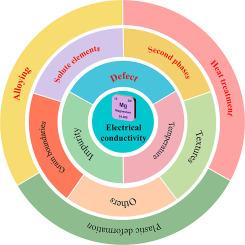Review of electrical conductivity in magnesium alloys: Mechanisms, strategies and applications
IF 13.8
1区 材料科学
Q1 METALLURGY & METALLURGICAL ENGINEERING
引用次数: 0
Abstract
Magnesium (Mg) alloys offer significant potential for conductive applications, thanks to their distinctive attributes, including high specific strength, excellent electrical conductivity (EC), low density, electromagnetic interference shielding effectiveness (EMI SE), and recyclability. However, a major challenge in Mg alloy research is balancing high strength with good EC, as strengthening these alloys often compromises their EC. This paper offers an in-depth analysis of the mechanisms, strategies, and applications aimed at improving the EC of Mg alloys. A bibliometric study is performed to uncover the main research trends and emerging hotspots within the field. The review then examines various strategies to improve EC focusing on factors such as solute elements, second phases, grain boundaries, textures, and vacancies. By carefully controlling alloy composition and optimizing heat treatment processes, significant advancements have been achieved by researchers in developing Mg alloys that possess both high strength and high EC, especially in Mg–Al, Mg–Zn, Mg–RE alloy systems and composites. Finally, the paper outlines future research directions, stressing the importance of further exploration into alloying element selection, heat treatment optimization, and other advanced strategies. These efforts are crucial for overcoming current challenges and expanding the application of Mg alloys in EC fields.

镁合金导电性研究进展:机理、策略及应用
镁(Mg)合金由于其独特的特性,包括高比强度、优异的导电性(EC)、低密度、电磁干扰屏蔽效率(EMI SE)和可回收性,在导电应用中具有巨大的潜力。然而,镁合金研究的一个主要挑战是平衡高强度和良好的电导率,因为强化这些合金通常会损害其电导率。本文深入分析了镁合金电导率提高的机理、策略和应用。通过文献计量学研究揭示了该领域的主要研究趋势和新兴热点。本文从溶质元素、第二相、晶界、织构和空位等方面探讨了提高电导率的各种策略。通过仔细控制合金成分和优化热处理工艺,研究人员在开发具有高强度和高EC的镁合金方面取得了重大进展,特别是在Mg - al, Mg - zn, Mg - re合金体系和复合材料方面。最后,展望了未来的研究方向,强调了进一步探索合金元素选择、热处理优化等先进策略的重要性。这些努力对于克服当前的挑战,扩大镁合金在电子电气领域的应用至关重要。
本文章由计算机程序翻译,如有差异,请以英文原文为准。
求助全文
约1分钟内获得全文
求助全文
来源期刊

Journal of Magnesium and Alloys
Engineering-Mechanics of Materials
CiteScore
20.20
自引率
14.80%
发文量
52
审稿时长
59 days
期刊介绍:
The Journal of Magnesium and Alloys serves as a global platform for both theoretical and experimental studies in magnesium science and engineering. It welcomes submissions investigating various scientific and engineering factors impacting the metallurgy, processing, microstructure, properties, and applications of magnesium and alloys. The journal covers all aspects of magnesium and alloy research, including raw materials, alloy casting, extrusion and deformation, corrosion and surface treatment, joining and machining, simulation and modeling, microstructure evolution and mechanical properties, new alloy development, magnesium-based composites, bio-materials and energy materials, applications, and recycling.
 求助内容:
求助内容: 应助结果提醒方式:
应助结果提醒方式:


